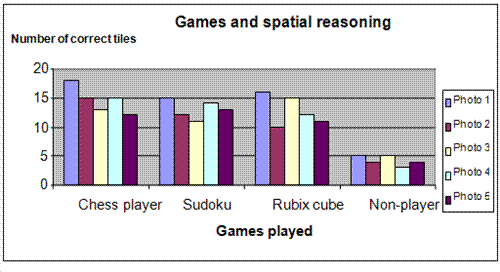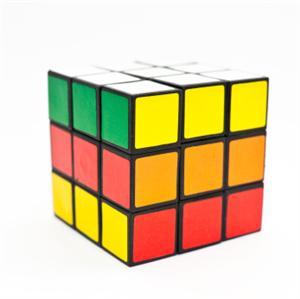| Complexity level: | 8 |
| Project cost ($): | 60 |
| Time required: | 1hour to prepare, 2 hours for the science fair project experiment |
| Material availability: | Lego sets can be purchased at a toy store (eg. Toys R Us) |
| Safety concerns: | Basic safety requirements |
Hypothesis
People who like to solve puzzles and play strategic games will possess better spatial reasoning skills.
Overview
Spatial reasoning
Intelligence is defined as the ability of a person to acquire knowledge and to apply it to practical use. Spatial reasoning is one of the eight types of intelligence. It is the ability of a person to recreate a visualized image in terms of its shape and measurements.
Spatial intelligence is an important part of major disciplines in education including computer science, engineering and mathematics. It is a fundamental method of analysis used by engineers, architects, mathematicians, scientists, inventors and designers in their professions.
Spatial reasoning actually goes beyond visualization and involves the ability of a person to analyze data and present them in spatial form so that they can be clearly understood. Engineers and scientists normally plot graphs to explain the complex relationships between different parameters. Spatial reasoning and thinking helps them to understand and analyze the information in the graphs.
Scientific Terms
Materials
The materials required for the science fair project :
- A regular chess player
- A regular sudoku enthusiast
- A Rubic cube expert
- A person who does not do puzzles or play strategy games (non-player)
- 4 Lego puzzle sets
- 5 photos of shapes built with 20 Lego tiles
- A stopwatch
- An assistant
Procedure
1. For this science fair project, the independent variable is the participant’s skill – a chess player, sudoku enthusiast, rubix cube expert and non-player. The dependent variable is his ability to reconstruct the Lego construction seen in the picture. This is determined by inspecting the Lego construction completed by the participants and counting the correct number of tiles used. The constants (control variables) are the number of Lego tiles used in construction, the length of time the participants are allowed to look at the photo and the time given to the participants to reconstruct the shape seen in the photo.
2. Four participants are selected for this science experiment – a chess player, sudoku enthusiast, rubix cube expert and a non-player. Each participant is given a set of Lego tiles (identical sets should be prepared).
3. The 4 participants are shown the first photo of a construction created using 20 Lego tiles. They are allowed to look at the photo for 30 seconds. After that the participants are given 5 minutes to reconstruct the shape in the photo using the Lego set provided.
4. After the 5 minutes, the number of tiles placed correctly within each participants construction, is counted and recorded in the table given below.
5. Procedures 4 and 5 are repeated using the remaining 4 photos of Lego constructions.

Results
The results showed that the chess player, sudoku puzzle player, and the rubix cube expert were able to assemble more Lego tiles correctly than the non-player participant.
|
Photo 1 |
Photo 2 |
Photo 3 |
Photo 4 |
Photo 5 |
|
|
Chess player |
18 |
15 |
13 |
15 |
12 |
|
Sudoku |
15 |
12 |
11 |
14 |
13 |
|
Rubic cube |
16 |
10 |
15 |
12 |
11 |
|
Non-player |
5 |
4 |
5 |
3 |
4 |
The chart below represents the results of our science project experiment.

Conclusion
Our hypothesis has been proven correct. People who like to solve puzzles and play strategic games will possess better spatial reasoning skills than those who don't like solving puzzles.
Spatial reasoning is an important form of intelligence that helps us understand and solve problems by visualization and mentally manipulating the images. Playing strategy games like chess or solving puzzles like the rubix cube and sudoku helps to train the brain and improve spatial thinking abilities. Introducing young children to these activities at an early age will help them to improve their intelligence.
Also consider
This science fair project may be repeated, this time, using standard tests for evaluating spatial reasoning abilities.
Try comparing the spatial reasoning abilities between genders and persons of different age groups.
Repeat the science project experiment, using a larger number of participants who play strategy games or solve puzzles regularly in order to improve the reliability and accuracy of our results.
References
Spatial temporal reasoning - http://en.wikipedia.org/wiki/Spatial-temporal_reasoning
Picture smart- Spatial reasoning and its role in cognition - http://serendip.brynmawr.edu/bb/neuro/neuro02/web3/czhan.html

